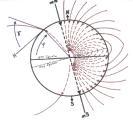Compass Bearings Hypothesis
Suns' Azimuth Hypothesis
Expansion-Contraction Hypothesis
Never Go Back Hypothesis
Hypotheses on flight tactics and
navigation of monarch butterflies



Kiepenheuer, Schmidt-Koenig, and Gibo Magnetoclinic,
Magnetic Latitude Hypothesis
Basic Idea:
Migrants from the eastern population of monarch butterflies navigating by the K/S-K magnetoclinic method are able to 'anticipate' and detour around the Gulf of Mexico . The butterflies accomplish this feat by rotating their preferred direction clockwise when they encounter a band of angles of inclination of the magnetic field ranging from approximately 65° to 55°. Isoclines of inclination of the geomagnetic field provide the butterflies with information on their approximate latitude.
Assumptions
- The overwintering sites in Mexico is the ultimate goal, and Eagles Pass, Texas is the intermediate goal, of the eastern population of migrating monarch butterflies.
- They have a sensor that can detect the angle of inclination of the geomagnetic field and can use this information to determine their courses and to determine their approximate latitude.
- Monarch butterflies navigate, at least in part, by the K/S-K mechanism.
- As a first approximation, the critical band of isoclines of magnetic inclination is assumed to extend from about 65° to 55°.
- When the Monarchs in route to the Gulf States detect that the angle of inclination of the magnetic field has declined (flattened) to about 65°, they begin to rotate their preferred directions clockwise towards the west.
- The rate of clockwise rotation of the preferred direction in response to a declining angle of inclination is assumed to much more rapid than the previous rate of counterclockwise rotation for the K/S-K route.
- Clockwise rotation of the preferred direction is assumed to peak at the 60° isocline of magnetic inclination.
- After the butterflies move past the 60° isocline, their response to the declining angle of inclination reverses and they rotate their preferred direction counterclockwise to the south.
- The rate at which the butterflies rotate their preferred direction counterclockwise while moving away from the 60° isocline is equivalent to their previous rate of clockwise rotation as they approached the isocline.
- By the time the butterflies reach the 55° isocline, they have returned to an K/S-K magnetoclinic course and a K/S-K rate of clockwise rotation.
- An unknown mechanism is responsible for the southward rotation of their courses once the migrants reach about 100° to 102° in northern Mexico.
Description of the behavior of a single butterfly according to the Hypothesis
While well north of the southeast states, the butterfly will attempt to fly a standard K/S-K magnetoclinic route. As it moves to lower latitudes, it gradually rotates its preferred direction counterclockwise in response to the steadily decreasing angle of inclination. The behavior of the butterfly changes when it finally reaches the 65° isocline of magnetic inclination. Instead of continuing to rotate its preferred direction counterclockwise in response to the steady decline in the angle of inclination, it begins to rotate its preferred direction clockwise. The rate of clockwise rotation is faster than the previous rate of counterclockwise rotation. The maximum westward rotation of the preferred direction is achieved at about the 60° isocline. As it passes the 60° isocline, its behavior abruptly changes again and it begins rotating its preferred direction counterclockwise in response to the declining angle of inclination. The rate of counterclockwise rotation is equal to the previous rate of clockwise rotation. If the butterfly had not yet reached approximately 100° of longitude in the region of south-central Texas and northern Mexico, its counterclockwise rotation would continue until it passed the 55° isocline of magnetic inclination. At this point, it is would once again be following a K/S-K magnetoclinic route and its rate of counterclockwise rotation of the preferred direction would have slowed to the normal rate for the K/S-K model. The result of the hypothesized clockwise rotation of preferred direction with respect of the K/S-K magnetoclinic route within the 65° to 55° band of isoclines of magnetic inclination is that the butterfly can approach the Gulf States anywhere along a broad front that extends East from about longitude 100° to about longitude 80° and be redirected westward through the Gulf States and into central Texas. On the other hand, once the butterfly reaches approximately 100° longitude in the region of south-central Texas and northern Mexico, an unknown influence causes it to adopt a preferred direction of south-southeast and fly parallel to the Sierra Madre Oriential.
Limitations of the Hypothesis
- Limited physiological evidence that monarch butterflies have sensors that can detect magnetic fields (However, see Jones and MacFadden, 1982)
- Boundaries of geographic region where the hypothesis applies are not known. May not apply to western population (See Remarks in Great Circle Hypothesis).
- Width of the critical band of isoclines of magnetic inclination is estimated.
- Isoclines of magnetic inclination are assumed to be smooth.
- Response of the butterflies to changing angles of inclination of the magnetic field is assumed to be uniform.
- Estimates of rate of rotation within critical band of isoclines of magnetic inclination is based on limited data.
- Hypothesis does not explain why the migrants turn SSE when they reach the about Longitude 100° to 102° in northern Mexico.
Advantages of Navigating by the Kiepenheuer, Schmidt-Koenig, and Gibo Magnetoclinic,
Magnetic Latitude method
- The single K/S-K route is sufficient for all migrants because butterflies starting from outside the center of distribution, and all those blown off course to the SE, will be redirected through the Gulf states into south-central Texas.
- The butterflies east of about 100° longitude can fly high above the ground and soar in thermals in a wide range of wind conditions because they are not wedded to a single route.
- Navigation is not affected by overcast skies.
- Magnetoclinic routes approximate Great Circle routes within in the range of monarch butterflies in eastern North America.
Problems of navigating by the Kiepenheuer, Schmidt-Koenig, and Gibo Magnetoclinic,
Magnetic Latitude method
- Migrants must continuously adjust their headings to avoid the Gulf while flying within the critical band of magnetic latitude.
- Magnetoclinic routes between two points are generally longer than Great Circle routes.
- Magnetic anomalies may mislead migrants
- Magnetic field precesses fairly rapidity in evolutionary time so that populations experience continuous natural selection to track changing magnetic coordinates.
Tests of the Kiepenheuer, Schmidt-Koenig, and Gibo Magnetoclinic, Magnetic Latitude
Hypothesis
Predictions
- Accepting the assumptions outlined above leads to the following predictions:
- During late summer and fall within the region bounded by approximately the 65° isocline of magnetic inclination in the North, the 55° isocline in the South, longitude 100° in the West, and the Atlantic Coast in the East, preferred directions of migrating monarch butterflies are rotated clockwise (westward) of the expected K/S-K bearing. Maximum westward rotation will occur at about the 60° isocline of magnetic inclination.
- Assuming that monarch butterflies returning in the spring orient by reversing the
K/S-K Magnetoclinic route (i.e. fly towards the increasing angle of inclination),
but continue to turn clockwise when they encounter the 55° to 65° band of magnetic
inclination, leads to the following predictions:
- During the spring within the region bounded by approximately the 55° isocline of magnetic inclination in the South, the 65° isocline in the North, longitude 100° in the West, and the Atlantic Coast in the East, preferred directions of the migrating monarch butterflies will be rotated clockwise (eastward) of the expected K/S-K bearing. Maximum eastward rotation will occur at about the 60° isocline of magnetic inclination.
- Assuming that the butterflies can detect magnetic coordinates, but are not 'aware' of
their location on the Globe (see hypothesis 2 in
the Remarks section of the Schmidt-Koenig Great Circle Hypothesis), that the butterflies
always try to fly a K/S-K routes, and that the mechanism that turns the eastern population
south to southeast ward in the region of longitude 100° to 102°, is restricted to this
section of Northern Mexico and south-central Texas, leads to a set of predictions for the
western population of monarch butterflies:
- During the late summer and fall within the region bounded by approximately the 65° isocline of magnetic inclination in the North, the 55° isocline in south, the Pacific Coast in the West, and longitude 110° in the East, preferred directions of migrating Monarch butterflies in the western population will be rotated clockwise (westward) of the expected K/S-K magnetoclinic bearing. Maximum westward rotation of the preferred direction will occur at about the 60° isocline of magnetic inclination.
- During the spring within the region bounded by approximately the 65° isocline of magnetic inclination in the North, the 55° in the South, the Pacific Coast in the West, and longitude 110° in the East, the preferred directions of migrating monarch butterflies will rotated clockwise of (eastward) of the expected K/S-K bearing. Maximum eastward rotation will occur at about the 60° isocline of magnetic inclination.
- Finally, by assuming that if monarch butterflies detect the earth's magnetic field,
they are like other organisms in that detect magnetic fields and are insensitive to the
North-South polarity, we can make a set of predictions for the population of monarch
butterflies in southeastern Australia:
- During late summer and fall in Australia within the region bounded by approximately the 65° isocline of magnetic inclination in the South, the 55° isocline in the North, and the South Pacific in the East, preferred directions of migrating monarch butterflies flying K/S-K magnetoclinic routes (i.e. NE in the southern hemisphere for the late summer and fall migration) will be rotated clockwise (eastward) of the expected K/S-K magnetoclinic bearing. Maximum eastward rotation of the preferred direction will occur at about the 60° isocline of magnetic inclination. Once the migrants penetrate northward of approximately 55° isocline, standard K/S-K routes will lead them to the NW coast of Queensland.
- During the spring migration, the same reversal predicted for North America is expected. The K/S-K magnetoclinic route will be SW for individuals that are north of approximately the 55° isocline of magnetic inclination. Within the 65° to 55° band of magnetic latitude, the preferred directions of the butterflies will be rotated clockwise (westward) of the expected K/S-K bearing, directing them further inland.
Methods
Note: There are up to five components to this test: (1) plotting the data as a Rose Diagram. (2) a Rayleigh test to determine if the vanishing bearings have a significant mean direction. If yes, then (3) an inspection of Rose Diagram to determine if data are obviously skewed or bimodal. If not, then (4) inspection of the diagram to determine if 95% Confidence Intervals include K/S-K Magnetoclinic route. If not, then (5) an inspection to of the diagram to determine if the K/S-K route is rotated clockwise, or counterclockwise of the arc formed by the mean vanishing bearing ±95% Confidence Intervals.
- Determine bearing for Magnetoclinic route from field site to center of the overwintering sites.
- Record at least 25 Category I, 50 Category II, or 100 Category III vanishing bearings of migrating monarch butterflies.
- Plot the data as a Rose diagram (a circular histogram). See the "Methods for Observing Migrating Butterflies" section of the Red Admiral and Painted Lady Web Site for an example of a Rose diagram. A string of dots can be used for each bearing instead of line segments.
- Calculate the mean vector (mean vanishing bearing) as shown in Batschelet (1981) or Zar (1996) and add to Rose diagram.
- Use the Rayleigh test in Batschelet (1981) or Zar (1996) to test if the mean vector (mean vanishing bearing) is significant. Proceed with analysis only if the mean vector is significant.
- Calculate the bearing for the K/S-K Magnetoclinic route (Kiepenheuer, 1984) and add to the Rose Diagram.
- Look up 95% Confidence Interval for mean bearing in Batschelet (1981) or in Zar (1996).
- Indicate the boundaries for 95% confidence limits on Rose Diagram (i.e. equal to mean bearing ±95% C.I.).
- Examine the Rose Diagram. If data are obviously skewed to one side, or bimodal (two peaks), you should not proceed with analysis. Data Analysis to this point has been a standard exercise in descriptive statistics. More complicated procedures are necessary to continue. If data are not obviously skewed or bimodal, proceed to Decision Rules.
Decision Rules
- If the expected bearing for K/S-K Magnetoclinic route falls within the arc delineated by 95% confidence limits for the mean vector than the two are not significantly different and hypothesis is rejected. Do not continue with the analysis.
- If bearing for Magnetoclinic route falls outside the arc delineated by the 95% confidence limits for the mean vector, then the two bearings are significantly different and hypothesis can not be rejected. Proceed to the appropriate category in step 3.
- A) Late summer and Fall migrants.
- If the arc delineated by the 95% confidence limits for the mean vector is rotated counterclockwise from the expected bearing for the K/S-K Magnetoclinic Route, than the hypothesis is rejected. Although the butterflies are not flying the K/S-K route, their preferred direction has been rotated eastward instead of westward.
- If the arc delineated by the 95% confidence intervals for the mean vector is rotated counterclockwise from the expected bearing for the K/S-K Magnetoclinic Route, than the hypothesis cannot be rejected. The butterflies have rotated their preferred direction in the predicted westward direction.
B) Spring migrants.
- If the arc delineated by the 95% confidence intervals for the mean vector is rotated counterclockwise from the expected bearing for K/S-K magnetoclinic route, then the hypothesis is rejected. Although the butterflies are not flying the K/S-K route, their preferred direction has been rotated westward instead of eastward.
- If the arc delimitated by the 95% confidence intervals for the mean vector is rotated counterclockwise from the expected bearing for the K/S-K Magnetoclinic Route, than the hypothesis cannot be rejected. The butterflies have rotated their preferred direction in the predicted eastward direction.
C) Western population migrants - Same as A) and B) above.
D) Australian migrants - Same as A) and B) above.
Remarks
This hypothesis occurred to me while writing a paper on Monarch butterfly migration
during my 1989/1990 sabbatical year. I realized that if the butterflies could determine
the angle of inclination, this was equivalent to knowing their latitude. The butterflies
could detour around the Gulf by rotating their preferred direction to the West at a
critical angle of magnetic inclination. I suggested that a critical band of magnetic
latitude exists, as opposed to a continuous adjustment of preferred direction as the
butterflies cross isoclines of magnetic latitude, for two reasons: (1) Schmidt-Koenig
(1985) found that monarch butterflies migrating in North Carolina had a mean vanishing
bearing that matched the theoretical bearing predicted by the K/S-K model, and (2) I had
recorded west vanishing bearings for migrants in Texas. Restricting any clockwise rotation
of the preferred direction to a critical band of magnetic latitude could explain the
discrepancy.
The lack of directional data for most of the United States leaves room for two alternate
versions of the K/S-K/G hypothesis: (1) the butterflies could continuously adjust their
preferred direction in response to the perceived flattening of the angle of inclination as
they move southward (i.e. no critical band of magnetic latitude exists), or (2)
they could abruptly rotate their preferred direction the maximum amount clockwise upon
entering the critical band of magnetic latitude, and abruptly rotate back to the expected
K/S-K bearing upon leaving the band (i.e. the hypothesized steady clockwise
rotation that peaks at the 60° isocline does not exist). Only an abundance of directional
data from many field sites can determine which, if any, of these hypotheses are viable.
Please Submit Your Data to Tactics and Vectors Archives
Please send copies of data and data analyses to Tactics and Vectors for inclusion in Archives. Non significant data is important information and can be used to discriminate among different theoretical models. Further instructions may be found in How to Submit Data to Tactics and Vectors (UNDER CONSTRUCTION).